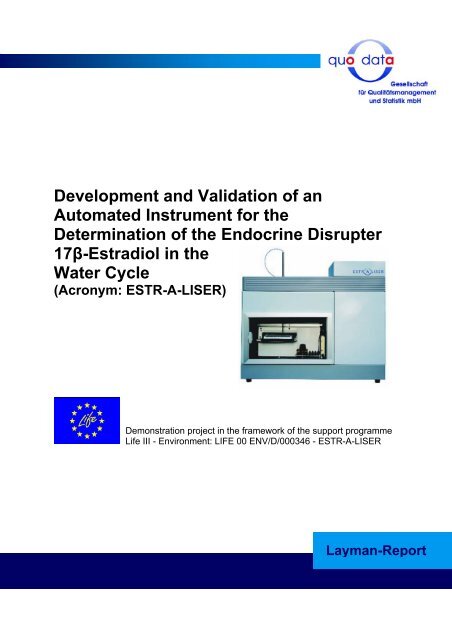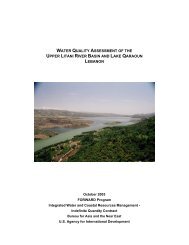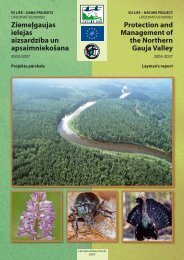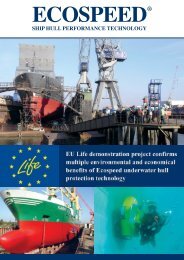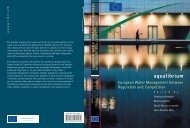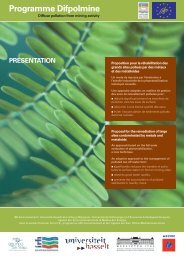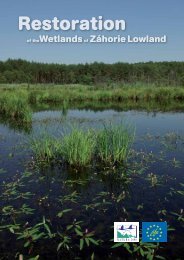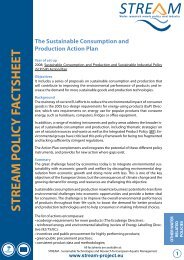Development and Validation of an Automated ... - wise-rtd.info
Development and Validation of an Automated ... - wise-rtd.info
Development and Validation of an Automated ... - wise-rtd.info
Create successful ePaper yourself
Turn your PDF publications into a flip-book with our unique Google optimized e-Paper software.
<strong>Development</strong> <strong><strong>an</strong>d</strong> <strong>Validation</strong> <strong>of</strong> <strong>an</strong><br />
<strong>Automated</strong> Instrument for the<br />
Determination <strong>of</strong> the Endocrine Disrupter<br />
17β-Estradiol in the<br />
Water Cycle<br />
(Acronym: ESTR-A-LISER)<br />
Demonstration project in the framework <strong>of</strong> the support programme<br />
Life III - Environment: LIFE 00 ENV/D/000346 - ESTR-A-LISER<br />
Laym<strong>an</strong>-Report
Beneficiary/ Project coordinator<br />
quo data GmbH<br />
Siedlerweg 20<br />
D-01465 Dresden-L<strong>an</strong>gebrück<br />
Germ<strong>an</strong>y<br />
Contact person<br />
Kirsten Simon<br />
Address<br />
quo data GmbH<br />
Birkenweiherstr. 9<br />
D-63505 L<strong>an</strong>genselbold<br />
Germ<strong>an</strong>y<br />
Email<br />
k.simon@quodata.de<br />
Homepage<br />
www.estraliser.de<br />
www.quodata.de
Laym<strong>an</strong> Report . Table <strong>of</strong> contents<br />
Table <strong>of</strong> contents<br />
1 Objective <strong>of</strong> the project......................................................................... 1<br />
2 Realization.............................................................................................. 5<br />
2.1 Immunoassays ............................................................................................. 5<br />
2.1.1 ELISA.................................................................................................... 6<br />
2.2 Statistical <strong>an</strong>alysis methods ......................................................................... 7<br />
2.3 Pipetting automat ......................................................................................... 7<br />
3 Results.................................................................................................... 8<br />
4 Effects on the environment .................................................................. 8<br />
5 Tr<strong>an</strong>sferability........................................................................................ 9<br />
6 Dissemination ........................................................................................ 9<br />
7 Acknowledgement............................................................................... 11<br />
quo data GmbH 10.11.2005
Laym<strong>an</strong> Report . Objective <strong>of</strong> the project<br />
1<br />
1 Objective <strong>of</strong> the project<br />
First sentence <strong>of</strong> the EU – Environmental Framework Directive 2000/60/EG:<br />
„Water is no common article <strong>of</strong> trade, but <strong>an</strong> inherited good that needs to be<br />
protected, defended <strong><strong>an</strong>d</strong> h<strong><strong>an</strong>d</strong>led adequately.“<br />
The Environmental Framework Directive <strong>of</strong> the Europe<strong>an</strong> Union (EU) 1 is a document<br />
that has been enacted by the EU member countries. It includes regulations that aim<br />
at assuring the water quality by active water protection. To achieve these aims,<br />
measuring systems <strong><strong>an</strong>d</strong> instruments that permit <strong>an</strong> examination <strong><strong>an</strong>d</strong> control <strong>of</strong> the<br />
water bodies are required.<br />
A large threat <strong>of</strong> waters - which c<strong>an</strong> hardly be evaluated so far - is posed by<br />
hormonal effective subst<strong>an</strong>ces that are classified as environmentally hazardous, the<br />
so-called endocrine disrupters (ED). Among them are all subst<strong>an</strong>ces that influence<br />
the endocrine system: besides the natural hormones these are the synthetically<br />
made hormones as well as other industrial chemicals that act like hormones or<br />
interfere with the hormonal regulation other<strong>wise</strong>.<br />
For fish <strong><strong>an</strong>d</strong> amphibi<strong>an</strong>s, these hazardous subst<strong>an</strong>ces <strong><strong>an</strong>d</strong> their toxicological effects<br />
are investigated largely. It is known that a concentration <strong>of</strong> 9 ng/L <strong>of</strong> the female<br />
sexual hormone<br />
17β-Estradiol in water causes a male roach to produce a female egg yolk protein<br />
(Vitellogenin) that under ordinary circumst<strong>an</strong>ces c<strong>an</strong> only be found in female fish.<br />
The concentration <strong>of</strong> the synthetic hormone 17α-Ethinylestradiol in water that causes<br />
a hormonal reaction is even lower. The male minnow <strong><strong>an</strong>d</strong> the male rainbowfish<br />
produce the female egg yolk protein at a concentration <strong>of</strong> 1 ng/L resp. at 0,1ng/L.<br />
For that reason this protein is a sensitive biochemical indicator <strong><strong>an</strong>d</strong> detecting this<br />
protein in fish indicates the pollution <strong>of</strong> waters with endocrine active subst<strong>an</strong>ces.<br />
More signs <strong>of</strong> hormonal effects <strong>of</strong> these subst<strong>an</strong>ces on different <strong>an</strong>imals <strong><strong>an</strong>d</strong> in<br />
different regions c<strong>an</strong> be found: frogs develop deformities <strong><strong>an</strong>d</strong> mussels develop<br />
1 Europe<strong>an</strong> Environmental Framework Directive 2000/60/EG <strong>of</strong> the Europe<strong>an</strong> Parliament <strong><strong>an</strong>d</strong> the Europe<strong>an</strong><br />
Council for determining a framework for joint regulation regarding water m<strong>an</strong>agement policy (October 23 rd ,<br />
2000).<br />
quo data GmbH 10.11.2005
Laym<strong>an</strong> Report . Objective <strong>of</strong> the project<br />
2<br />
defective shells. In Florida alligators showed damages <strong>of</strong> the genitals after a DDTaccident.<br />
No direct d<strong>an</strong>ger for the hum<strong>an</strong>s could be detected so far, however several<br />
phenomena are being attributed to the effects <strong>of</strong> endocrine active subst<strong>an</strong>ces.<br />
A widespread hypothesis by Skakkebeak <strong><strong>an</strong>d</strong> Sharpe indicates that the quality<br />
decrease <strong>of</strong> spermatozoa <strong>of</strong> the western males is caused by the influence <strong>of</strong><br />
endocrine disrupters. Additionally <strong>an</strong> increased risk <strong>of</strong> breast c<strong>an</strong>cer for females is<br />
known for the artificially produced 17β-Estradiol.<br />
A direct effect on hum<strong>an</strong>s, e.g. by drinking water that demonstrably contains<br />
endocrine subst<strong>an</strong>ces, could not be determinded so far, but the current research<br />
assumes <strong>an</strong> end<strong>an</strong>gering <strong>of</strong> adolescent children <strong><strong>an</strong>d</strong> embryos.<br />
The biggest end<strong>an</strong>gering <strong>of</strong> hum<strong>an</strong>s by endocrine active subst<strong>an</strong>ces is the fact that<br />
these subst<strong>an</strong>ces imitate hum<strong>an</strong> hormones.<br />
With specific hormones the production <strong>of</strong> org<strong>an</strong>s in the embryo c<strong>an</strong> be controlled.<br />
Therefore the presence <strong>of</strong> <strong>an</strong> effective hormone in the body at a not intended point <strong>of</strong><br />
time may cause badly damages <strong>of</strong> the org<strong>an</strong>s.<br />
The most import<strong>an</strong>t industrial chemicals containing endocrine active subst<strong>an</strong>ces are<br />
17α-Ethinylestradiol, Bisphenol A, Nonylphenol <strong><strong>an</strong>d</strong> Phthalates.<br />
Between the endocrine disrupters, the so-called birth control pill hormon 17α-<br />
Ethinylestradiol is considered as being especially active (below 0,1 ng/L). It c<strong>an</strong> be<br />
found in sewage water due to hum<strong>an</strong> excrements <strong><strong>an</strong>d</strong> the disposal <strong>of</strong> pharmaceutical<br />
products into sewer systems.<br />
Bisphenol A is employed in the production <strong>of</strong> plasticisers, resins, lacquers,<br />
colourings, pesticides <strong><strong>an</strong>d</strong> <strong>an</strong>tioxid<strong>an</strong>ts. By the elutriation <strong>of</strong> material the subst<strong>an</strong>ce<br />
gets into the environment.<br />
Nonylphenol <strong>of</strong>ten occurs as a tenside in industrial cle<strong>an</strong>ers. Although these are<br />
voluntarily not used <strong>an</strong>ymore by the industry since 1992, Nonylphenols are still a<br />
component <strong>of</strong> import products as adhesives as well rubber <strong><strong>an</strong>d</strong> caoutchouc products.<br />
Phthalates are plasticisers employed in the production <strong>of</strong> PVC <strong><strong>an</strong>d</strong> other synthetics<br />
that c<strong>an</strong> be elutriated <strong><strong>an</strong>d</strong> reach the sewage water where they c<strong>an</strong> develop a strong<br />
toxicity for aquatic creatures.<br />
The examples for endocine active subst<strong>an</strong>cec c<strong>an</strong> be continued <strong><strong>an</strong>d</strong> the number <strong>of</strong><br />
toxic subst<strong>an</strong>ces is increasing. A current list <strong>of</strong> endocrine disrupters was introduced<br />
quo data GmbH 10.11.2005
Laym<strong>an</strong> Report . Objective <strong>of</strong> the project<br />
3<br />
by Wenzel, Müller und Ternes in 2003 in their study about those disrupters in<br />
drinking water.<br />
However not discussed in detail, biocides 2 , pesticides 3 <strong><strong>an</strong>d</strong> POP´s (Persistent<br />
Org<strong>an</strong>ic Pollut<strong>an</strong>ts 4 ) play <strong>an</strong> import<strong>an</strong>t role that also exhibit a large relev<strong>an</strong>ce as<br />
endocrine active subst<strong>an</strong>ces.<br />
The import<strong>an</strong>ce <strong>of</strong> the endocrine active subst<strong>an</strong>ces increases due to the m<strong>an</strong>y<br />
possibilities <strong>of</strong> entering the environment. As the main input pathway in the<br />
environment the water <strong><strong>an</strong>d</strong> weather cycle c<strong>an</strong> be considered. Latest knowledge<br />
demonstrate the connection <strong>of</strong> input pathways over the whole globe. Within some<br />
days harmful subst<strong>an</strong>ces c<strong>an</strong> be carried over the globe <strong><strong>an</strong>d</strong> cause pollution in a<br />
different region.<br />
An import<strong>an</strong>t input pathway as well is the communal <strong><strong>an</strong>d</strong> industrial sewage.<br />
Conventional sewage treatment pl<strong>an</strong>ts show a very different efficiency in the<br />
elimination <strong>of</strong> complex chemical subst<strong>an</strong>ces. Therefore endocrine disrupters may be<br />
eliminated only insufficiently.<br />
These remarks show the signific<strong>an</strong>ce <strong>of</strong> endocrine active subst<strong>an</strong>ces for the whole<br />
society <strong><strong>an</strong>d</strong> therewith the potential d<strong>an</strong>ger for hum<strong>an</strong>s <strong><strong>an</strong>d</strong> <strong>an</strong>imals. Through this the<br />
necessity to measure these subst<strong>an</strong>ces precisely with reliable measuring systems<br />
<strong><strong>an</strong>d</strong> instruments becomes clear.<br />
The measuring <strong>of</strong> small concentrations is especially required to establish dose-effectrelations<br />
<strong><strong>an</strong>d</strong> to evaluate the efficiency <strong>of</strong> sewage treatment techniques.<br />
Present measurement technologies for the recording <strong>of</strong> water pollution use gas<br />
chromatography <strong><strong>an</strong>d</strong> mass spectrometry as st<strong><strong>an</strong>d</strong>ard <strong>an</strong>alysis. Two approved<br />
methods that however are extensive, cause high costs, take up a lot <strong>of</strong> time, require<br />
qualified personnel as well as a special <strong><strong>an</strong>d</strong> expensive instrument. Furthermore<br />
before the actual measuring, sample enrichment <strong><strong>an</strong>d</strong> a cle<strong>an</strong>-up step that is<br />
supposed to minimise matrix effects (influences on the measurement results due to<br />
surrounding conditions) have to be carried. Both steps introduce new sources <strong>of</strong><br />
error, lower reliability <strong><strong>an</strong>d</strong> reproducibility <strong>of</strong> results <strong><strong>an</strong>d</strong> increase the costs <strong><strong>an</strong>d</strong><br />
duration <strong>of</strong> the <strong>an</strong>alysis.<br />
2 Among them TBT (Tributylzinn)<br />
3 Among them Isuproturon, Dioron, Endosulf<strong>an</strong>, Atrazine<br />
4 Among them DDT, Dioxin, PCB´s, Fur<strong>an</strong>e<br />
quo data GmbH 10.11.2005
Laym<strong>an</strong> Report . Objective <strong>of</strong> the project<br />
4<br />
An alternative is a method that has been successfully applied in medical science –<br />
the immunoassays in the form <strong>of</strong> ELISA-Tests (Enzyme-Linked ImmunoSorbent<br />
Assay). The tr<strong>an</strong>sfer <strong>of</strong> this method to the field <strong>of</strong> environmental <strong>an</strong>alyses is new <strong><strong>an</strong>d</strong><br />
has not been ventured yet, since concentrations are in n<strong>an</strong>ogram in this application<br />
field.<br />
To get <strong>an</strong> idea <strong>of</strong> the dimensions: a concentration <strong>of</strong> 1 ng/L equals - regarding the<br />
endocrine disrupters - e.g. 200g 17α-Ethinylestradiol in the Chiemsee, the second<br />
largest lake in Germ<strong>an</strong>y. Measurements in this r<strong>an</strong>ge <strong>of</strong> concentration could not be<br />
accomplished reliably with ELISA-Tests so far.<br />
On this account the quo data GmbH <strong><strong>an</strong>d</strong> the project partners, the University <strong>of</strong> Bonn<br />
(Germ<strong>an</strong>y) <strong><strong>an</strong>d</strong> the University <strong>of</strong> Aveiro (Portugal) as well as the Federal<br />
Environment Agency GmbH Vienna (Austria), applied a demonstration project within<br />
the framework <strong>of</strong> the support programme LIFE III – Environment which aimed at<br />
developing ELISA-Tests for a special subst<strong>an</strong>ce for the first time <strong><strong>an</strong>d</strong> optimising them<br />
by statistical <strong>an</strong>alysis methods in order to obtain valid results.<br />
Together with the project partners, the quo data GmbH met this challenge <strong><strong>an</strong>d</strong><br />
developed <strong>an</strong> automated <strong>an</strong>alytical system for the determination <strong>of</strong> endocrine active<br />
subst<strong>an</strong>ces (examplarily for the estrogen 17ß-Estradiol) within the limits <strong>of</strong> the project<br />
duration.<br />
quo data GmbH 10.11.2005
Laym<strong>an</strong> Report . Realization<br />
5<br />
2 Realization<br />
2.1 Immunoassays<br />
Immunoassays are chemical tests used to detect or qu<strong>an</strong>tify a specific subst<strong>an</strong>ce,<br />
the <strong>an</strong>alyte, in a blood or body fluid sample, using <strong>an</strong> immunological reaction.<br />
Immunoassays are highly sensitive <strong><strong>an</strong>d</strong> specific. Their high specificity results from<br />
the use <strong>of</strong> <strong>an</strong>tibodies <strong><strong>an</strong>d</strong> purified <strong>an</strong>tigens as reagents. An <strong>an</strong>tibody is a protein<br />
(immunoglobulin) produced by B-lymphocytes (immune cells) in response to<br />
stimulation by <strong>an</strong> <strong>an</strong>tigen. Immunoassays measure the formation <strong>of</strong> <strong>an</strong>tibody-<strong>an</strong>tigen<br />
complexes <strong><strong>an</strong>d</strong> detect them via <strong>an</strong> indicator reaction.<br />
The purpose <strong>of</strong> <strong>an</strong> immunoassay is to measure <strong>an</strong> <strong>an</strong>alyte. Common uses include<br />
measurement <strong>of</strong> drugs, hormones, specific proteins, tumor markers, <strong><strong>an</strong>d</strong> markers <strong>of</strong><br />
cardiac injury. Radioimmunoassay (RIA) is a method employing radioactive<br />
isotopes to label either the <strong>an</strong>tigen or <strong>an</strong>tibody. The major adv<strong>an</strong>tages <strong>of</strong> RIA,<br />
compared with other immunoassays, are higher sensitivity, easy signal detection,<br />
<strong><strong>an</strong>d</strong> well-established, rapid assays. The major disadv<strong>an</strong>tages are the health <strong><strong>an</strong>d</strong><br />
safety risks posed by the use <strong>of</strong> radiation <strong><strong>an</strong>d</strong> the time <strong><strong>an</strong>d</strong> expense associated with<br />
maintaining a licensed radiation safety <strong><strong>an</strong>d</strong> disposal program.<br />
Enzyme immunoassay (EIA) as developed as <strong>an</strong> alternative to radioimmunoassay<br />
(RIA). These methods use <strong>an</strong> enzyme to label either the <strong>an</strong>tibody or <strong>an</strong>tigen. The<br />
sensitivity <strong>of</strong> EIA approaches that for RIA, without the d<strong>an</strong>ger posed by radioactive<br />
isotopes. One <strong>of</strong> the most widely used EIA methods is the enzyme-linked<br />
immunosorbent assay (ELISA).<br />
For a long time immunoassays belong to the routine methods in biochemistry <strong><strong>an</strong>d</strong><br />
medical diagnosis. However in the last 10-15 years their import<strong>an</strong>ce in different areas<br />
like the environmental <strong>an</strong>alysis <strong><strong>an</strong>d</strong> food inspection increased intensely. They are<br />
used for the determination <strong>of</strong> environmental contaminates (aromatic hydrocarbons,<br />
pesticides or explosives in soil or water), food additive <strong><strong>an</strong>d</strong> pharmaceuticals.<br />
For the determination <strong>of</strong> subst<strong>an</strong>ces with small sizes <strong>of</strong> molecules, immunoassays<br />
compete with chromatographic methods that are mainly applied today.<br />
Immunoassays have several adv<strong>an</strong>tages compared to other <strong>an</strong>alytical methods: they<br />
are fast <strong><strong>an</strong>d</strong> inexpensive <strong><strong>an</strong>d</strong> the <strong>an</strong>alysis does not require long-winded cle<strong>an</strong>-up<br />
quo data GmbH 10.11.2005
Laym<strong>an</strong> Report . Realization<br />
6<br />
steps for the samples. Thereby a high number <strong>of</strong> samples c<strong>an</strong> be <strong>an</strong>alysed in a short<br />
time <strong><strong>an</strong>d</strong> the needed sample volume is low. Additionally this method is suited for <strong>an</strong><br />
automation.<br />
2.1.1 ELISA<br />
The first step <strong>of</strong> <strong>an</strong> ELISA is coating a microtiter plate with <strong>an</strong>tibodies that c<strong>an</strong> bind to<br />
the <strong>an</strong>alyte. For this purpose a small amount (e.g. 5 µL) <strong>of</strong> the <strong>an</strong>tibody serum is<br />
diluted (e.g. 1:50.000) in a special buffer solution. This buffer solution corresponds to<br />
the characteristics (pH value, ionic strength) <strong>of</strong> the serum fluid in blood from where<br />
the <strong>an</strong>tibodies were being isolated. From this solution a defined volume (200 µL) is<br />
being pipetted in the wells <strong>of</strong> the microtiter plate. The plate is shaken over a defined<br />
time <strong><strong>an</strong>d</strong> the <strong>an</strong>tibodies adsorb on the surface. Afterwards excrescent <strong>an</strong>tibodies are<br />
edulcorated by a special washing buffer. Now the sample that contains the <strong>an</strong>alyte<br />
(i.e. the subst<strong>an</strong>ce to be determined) is added. The next step consists <strong>of</strong> a short<br />
waiting time (pre incubation). While this time, the molecules <strong>of</strong> the <strong>an</strong>alyte c<strong>an</strong> bind to<br />
the <strong>an</strong>tibodies that adhere to the surface. Following the so-called enzyme tracer is<br />
added. An enzymer tracer is <strong>an</strong> <strong>an</strong>alyte molecule that is bound to <strong>an</strong> enzyme that<br />
catalyses a specific reaction, at the end the product <strong>of</strong> this reaction c<strong>an</strong> be<br />
measured. The enzyme tracer is also diluted with a specific buffer solution. During a<br />
second incubation time, the enzyme tracer competes with the <strong>an</strong>alyte over the<br />
binding sites <strong>of</strong> the <strong>an</strong>tibody due to the structural similarity. The unbound <strong>an</strong>alyte <strong><strong>an</strong>d</strong><br />
enzyme tracer are being washed out afterwards, while a part <strong>of</strong> the added enzyme<br />
tracer is remaining bound on the surface. The amount <strong>of</strong> the bound enzyme tracer<br />
c<strong>an</strong> be made observable by adding a special substrate solution. This solution<br />
contains two subst<strong>an</strong>ces <strong><strong>an</strong>d</strong> their reaction is catalysed by the bound enzyme.<br />
Thereby the colourless input product becomes a coloured reaction product that is<br />
optically ascertainable. In the last step the interruption <strong>of</strong> the catalysed reaction is<br />
caused by adding sulphuric acid. Again a ch<strong>an</strong>ge <strong>of</strong> colour is taking place.<br />
Since enzyme tracer <strong><strong>an</strong>d</strong> <strong>an</strong>alyte competed over the available binding sites, from the<br />
intensity <strong>of</strong> the colouration the amount <strong>of</strong> the bound <strong>an</strong>alyte c<strong>an</strong> be concluded. Since<br />
only the enzyme tracer possesses the property to catalyse, <strong>an</strong> intensive colouration<br />
indicates a big amount <strong>of</strong> bound tracer, but small amount <strong>of</strong> bound <strong>an</strong>alyte while a<br />
faint colouration indicates a small amount <strong>of</strong> bound tracer <strong><strong>an</strong>d</strong> a big amount <strong>of</strong> bound<br />
quo data GmbH 10.11.2005
Laym<strong>an</strong> Report . Realization<br />
7<br />
<strong>an</strong>alyte. The intensity <strong>of</strong> the colouration (optical density) is mesaured by a microtiter<br />
plate photometer.<br />
2.2 Statistical <strong>an</strong>alysis methods<br />
Besides the immunochemical st<strong><strong>an</strong>d</strong>ardisation <strong>of</strong> the ELISA-Tests, statistical methods<br />
for the design <strong>of</strong> experiments <strong><strong>an</strong>d</strong> the <strong>an</strong>alysis <strong>of</strong> the samples as well as the<br />
measurement results are <strong>of</strong> utmost import<strong>an</strong>ce.<br />
The r<strong><strong>an</strong>d</strong>omised pipetting <strong>of</strong> the microtiter plate minimises measurement errors by a<br />
defective microtiter plater. In addition to this possibility to arr<strong>an</strong>ge the samples, also a<br />
calibration on the basis <strong>of</strong> st<strong><strong>an</strong>d</strong>ards c<strong>an</strong> be carried out by using a regression, the<br />
maximum-likelihood-estimator. Following with the help <strong>of</strong> the calibration curve that<br />
depends on the st<strong><strong>an</strong>d</strong>ards or with the help <strong>of</strong> the robust me<strong>an</strong> value <strong>of</strong> the samples a<br />
trend c<strong>an</strong> be calculated. With this trend <strong>an</strong>alysis the estimation <strong>of</strong> the concentrations<br />
by including all samples is carried out.<br />
For very precise results that are unassailable in front <strong>of</strong> the court, the <strong>an</strong>alysis<br />
s<strong>of</strong>tware <strong>of</strong>fers the possibility to specify the measurement uncertainty <strong><strong>an</strong>d</strong> the limit <strong>of</strong><br />
detection by the Bootstrap method.<br />
2.3 Pipetting automat<br />
The ESTR-A-LISER has been designed on the basis <strong>of</strong> specifications from the<br />
optimisation <strong>of</strong> ELISA-Tests as well as from the statistical preliminary <strong>an</strong>alyses.<br />
The essential part <strong>of</strong> the instrument is a pipetting automat that is controlled by a<br />
newly developed s<strong>of</strong>tware which ensures a narrow control <strong>of</strong> the whole measurement<br />
procedure.<br />
The automat enables a time <strong><strong>an</strong>d</strong> amount exact pipetting <strong>of</strong> samples, st<strong><strong>an</strong>d</strong>ards <strong><strong>an</strong>d</strong><br />
reagents. The s<strong>of</strong>tware also controls the tempering device that keeps the automat on<br />
a stable temperature during the procedure. The temperature c<strong>an</strong> be determined<br />
within the r<strong>an</strong>ge <strong>of</strong> 18°C <strong><strong>an</strong>d</strong> 40°C.<br />
Before starting the measurements, all single steps <strong>of</strong> the ELISA are defined in the<br />
control s<strong>of</strong>tware, including the volumes <strong><strong>an</strong>d</strong> waiting times. Furthermore the order in<br />
which the samples <strong><strong>an</strong>d</strong> st<strong><strong>an</strong>d</strong>ards are finalised is defined. Afterwards all necessary<br />
reagents (samples, st<strong><strong>an</strong>d</strong>ards, immunochemical reagents) as well as the microtiter<br />
plate are placed into the automat. This is the only m<strong>an</strong>ual step during the test.<br />
Thereby effects by different users are almost completely eliminated. The necessary<br />
quo data GmbH 10.11.2005
Laym<strong>an</strong> Report . Results . Effects on the environment<br />
8<br />
buffer solution that is needed for the washing step is provided from a container<br />
outside <strong>of</strong> the pipetting system. During the test, the pipetting needle is cle<strong>an</strong>ed in the<br />
wash station between every single pipetting step to avoid the displacing <strong>of</strong> reagents.<br />
The absorption reader for the determination <strong>of</strong> the optical density at the end <strong>of</strong> the<br />
procedure is integrated in the automat <strong><strong>an</strong>d</strong> forwards the measurement result to the<br />
control s<strong>of</strong>tware automatically. The integrated <strong>an</strong>alysis s<strong>of</strong>tware provides a detailed<br />
report <strong>of</strong> the results. Due to the almost complete automation the instrument is easy to<br />
operate.<br />
3 Results<br />
By me<strong>an</strong>s <strong>of</strong> highly sensitive immunoassays <strong><strong>an</strong>d</strong> st<strong><strong>an</strong>d</strong>ardised ELISA-Tests very<br />
small limits <strong>of</strong> detection were received without the complex cle<strong>an</strong>-up steps.<br />
The statistical methods ensure reliable measurement values, since the determined<br />
concentrations are specified together with e.g. the extended measurement<br />
uncertainty.<br />
Within the project, the prototype <strong>of</strong> the ESTR-A-LISER was employed successfully in<br />
several validation <strong><strong>an</strong>d</strong> field studies for surface water <strong><strong>an</strong>d</strong> sewage treatment pl<strong>an</strong>ts,<br />
thereby limits <strong>of</strong> detection <strong>of</strong> 2 ng/L were obtained. In the routine operation between<br />
10 <strong><strong>an</strong>d</strong> 20 samples per day c<strong>an</strong> be <strong>an</strong>alysed by the automat.<br />
4 Effects on the environment<br />
With the examples <strong>of</strong> 17β-Estradiol <strong><strong>an</strong>d</strong> 17α-Ethinylestradiol the successful<br />
demonstration project showed that by me<strong>an</strong>s <strong>of</strong> ELISA-Tests with <strong>an</strong> adequate<br />
st<strong><strong>an</strong>d</strong>ardisation <strong><strong>an</strong>d</strong> automation in combination with statistical methods small limits <strong>of</strong><br />
detections c<strong>an</strong> be obtained validly. This technology permits the production <strong>of</strong><br />
inexpensive automats that easily c<strong>an</strong> be adapted to further ELISA-Tests for the<br />
determination <strong>of</strong> other subst<strong>an</strong>ces.<br />
Since by the EU – Environmental Framework Directive a multitude <strong>of</strong> subst<strong>an</strong>ces is<br />
classified as potentially hazardous to water, a measuring system that c<strong>an</strong> be applied<br />
quo data GmbH 10.11.2005
Laym<strong>an</strong> Report . Tr<strong>an</strong>sferability . Dissemination<br />
9<br />
flexibly to a great number <strong>of</strong> subst<strong>an</strong>ces could be created by these technologies.<br />
Thus <strong>an</strong> import<strong>an</strong>t instrument for the environmental <strong>an</strong>alysis could be the result in the<br />
near future.<br />
5 Tr<strong>an</strong>sferability<br />
The tr<strong>an</strong>sferability <strong>of</strong> the used methodology <strong><strong>an</strong>d</strong> the immunochemical procedure<br />
depends on the properties <strong>of</strong> the subst<strong>an</strong>ce to be measured. The already mentioned<br />
water hazardous subst<strong>an</strong>ces <strong>of</strong> the EU-Directive possess relatively different chemical<br />
structures <strong><strong>an</strong>d</strong> properties. The characterisations <strong><strong>an</strong>d</strong> prerequisites that underlie the<br />
immunoassays require specific binding properties <strong>of</strong> a subst<strong>an</strong>ce in order that a<br />
measurement with ELISA-Test is possible. For every subst<strong>an</strong>ce it has to be verified if<br />
the requirements are met.<br />
6 Dissemination<br />
On m<strong>an</strong>y occasions the quo data GmbH presented the results <strong>of</strong> the demonstration<br />
project ESTR-A-LISER in front <strong>of</strong> laymen <strong><strong>an</strong>d</strong> experts.<br />
Like<strong>wise</strong> m<strong>an</strong>y PR-activities c<strong>an</strong> be named where the quo data GmbH <strong>info</strong>rmed<br />
about the research project in form <strong>of</strong> press releases for the daily newspapers <strong><strong>an</strong>d</strong><br />
pr<strong>of</strong>essional articles in scientific journals.<br />
Additionally the quo data GmbH <strong><strong>an</strong>d</strong> the project partners are taking part in scientific<br />
symposiums that deal with endocrine active subst<strong>an</strong>ces. At this scientists present<br />
particular aspects <strong>of</strong> the research <strong><strong>an</strong>d</strong> development project in form <strong>of</strong> papers, posters<br />
<strong><strong>an</strong>d</strong> lectures to the interested expert audience 5 . The participation <strong>of</strong> quo data<br />
employees in research networks about endocrine active subst<strong>an</strong>ces also plays <strong>an</strong><br />
import<strong>an</strong>t role. Considering the Water M<strong>an</strong>agement Initiative <strong>of</strong> the North Rhine-<br />
5 Example: Endo-Workshop: ESTR-A-LISER: automated immunoassays for the determination <strong>of</strong> the endocrine<br />
active subst<strong>an</strong>ces 17β-Estradiol <strong><strong>an</strong>d</strong> 17α-Ethinylestradiol in surface <strong><strong>an</strong>d</strong> sewage water. Dresden 2005.<br />
quo data GmbH 10.11.2005
Laym<strong>an</strong> Report . Dissemination<br />
10<br />
Westphalia as <strong>an</strong> example, the positive effect <strong>of</strong> research networks that enables <strong>an</strong><br />
active exch<strong>an</strong>ge <strong><strong>an</strong>d</strong> <strong>info</strong>rmation tr<strong>an</strong>sfer between experts becomes clear.<br />
An especially good platform for the dissemination <strong>of</strong> the results <strong>of</strong>fered the final event<br />
<strong>of</strong> the ESTR-A-LISER project in the BioZentrum at the University <strong>of</strong> Bonn, which was<br />
org<strong>an</strong>ised by the quo data GmbH <strong><strong>an</strong>d</strong> the project partner on April 8 th 2005.<br />
A multitude <strong>of</strong> experts from the fields <strong>of</strong> <strong>an</strong>alytical chemistry <strong><strong>an</strong>d</strong> environmental<br />
<strong>an</strong>alysis as well as from institutes <strong>of</strong> water m<strong>an</strong>agement was invited to this final<br />
event.<br />
The daily <strong><strong>an</strong>d</strong> scientific press was also invited <strong><strong>an</strong>d</strong> m<strong>an</strong>y articles about the event<br />
were released.<br />
The different activities <strong>of</strong> the research partner created a wide interest in the project.<br />
M<strong>an</strong>y requests by practitioners from economy <strong><strong>an</strong>d</strong> research regarding the status quo<br />
or the functionality <strong>of</strong> the ESTR-A-LISER reached the quo data GmbH.<br />
Another import<strong>an</strong>t component for the communication <strong>of</strong> the research activities <strong><strong>an</strong>d</strong><br />
results is the homepage www.estraliser.de which has been const<strong>an</strong>tly updated with<br />
new <strong>info</strong>rmation by quo data employees <strong><strong>an</strong>d</strong> thereby led to a widespread public<br />
notice <strong>of</strong> the research project.<br />
The perm<strong>an</strong>ent contact <strong>of</strong> the quo data GmbH <strong><strong>an</strong>d</strong> the project partners to other<br />
scientists results in the positive evaluation <strong>of</strong> the demonstration project which is<br />
continued as a new project PHARM-A-LISER. With the exp<strong>an</strong>sion <strong>of</strong> the<br />
measurement system to subst<strong>an</strong>ces that are endocrine <strong><strong>an</strong>d</strong> pharmaceutical active,<br />
shows their further import<strong>an</strong>ce in the future as well as the necessity <strong>of</strong> precise<br />
measuring <strong><strong>an</strong>d</strong> determination <strong>of</strong> toxicological subst<strong>an</strong>ces in the environment.<br />
quo data GmbH 10.11.2005
Laym<strong>an</strong> Report . Acknowledgement<br />
11<br />
7 Acknowledgement<br />
The quo data GmbH as project coordinator would like to th<strong>an</strong>k:<br />
Europe<strong>an</strong> Commission within the framework <strong>of</strong> the fin<strong>an</strong>cial support programme LIFE<br />
III – Environment<br />
Co-fin<strong>an</strong>ced by the <strong>Development</strong> B<strong>an</strong>k <strong>of</strong> Saxony (SAB)<br />
Project partner:<br />
• University <strong>of</strong> Bonn . Institute <strong>of</strong> Agricultural Chemistry<br />
Karlrobert-Kreiten Straße 13<br />
53115 Bonn, Germ<strong>an</strong>y<br />
Contact person: PD Dr. R. Schneider<br />
• Federal Environment Agency GmbH . Analytical Chemistry<br />
Spittelauer Lände 5<br />
1090 Wien, Austria<br />
Contact person: DI P. Hohenblum<br />
• University <strong>of</strong> Aveiro . Chemistry Department<br />
Analytical Chemistry Group<br />
3810-193 Aveiro, Portugal<br />
Contact person: Pr<strong>of</strong>. Dr. Esteves<br />
quo data GmbH 10.11.2005


